#john j. wozniak
Explore tagged Tumblr posts
Text
Crowdfunding Corner: Cherry's Jubilee Collection by Underground Comics Legend Larry Welz
Crowdfunding Corner: Cherry's Jubilee Collection by Underground Comics Legend Larry Welz #comics #comicbooks
Backer Beware: Crowdfunding projects are not guaranteed to be delivered and/or delivered when promised. We always recommend to do your research before backing. Cherry ‘Poptart’ is most likely the Best-Selling Adult comic book of all time. Now is your chance to own an entire chapter of Cherry Herstory in one book! Discordia has launched a Kickstarter for the first ever trade paperback…

View On WordPress
#cherrys jubilee#chris tirri#chuck austen#Dan Fogel#Dave Warren#discordia publishing#duke roosevelt#forg#Geoffrey C. Everts#Greg Espinoza#Jim Pitts#john j. wozniak#justine blanco#kate worley#larry todd#larry welz#lee terry#leslie sternbergh#lew reid#mark bode#marv wolfman#Molly Kiely#R.C. Harvey#richard green#ross ptasynski#S.E. Mills#steven crompton#trade paperback#trade paperbacks#Zoot Vlezenbeek
0 notes
Text
The brackets are finally here!

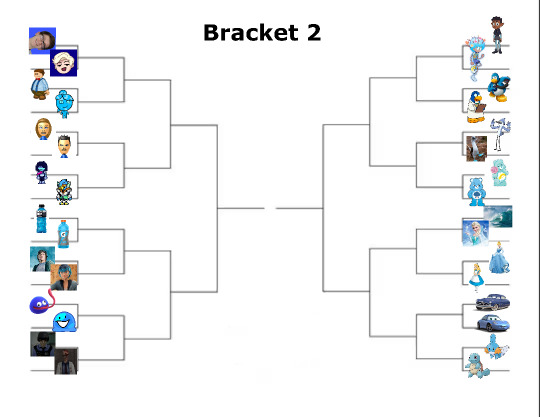
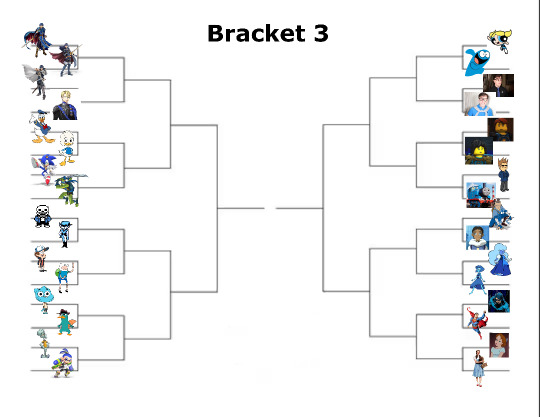



(sorry for the poor quality of the bracket images lol it’s the best i could do)
Two quick propaganda rules:
1. Propaganda is good and encouraged, just don’t send any negative propaganda. This tournament is for fun, and anti-propaganda kinda ruins that.
2. If you do make propaganda, you can either send it through my ask box, or you can reblog the post with your propaganda. Either is fine!
These 6 brackets will go on until there’s only one character left in each. Once the six semi-finalists are chosen, there will be two battles of 3, and then the winners of that will go against each other in the finals! Each poll will last for one day, but the finals and semifinals will be a week each. The posting schedule will be one bracket a day, meaning that day 1 will be bracket 1 round 1, day 2 will be bracket 2 round 1, and so on. The first set of polls will drop tomorrow (March 30) at roughly 4:00 PM EST. Now, onto the actual matchups!
Bracket 1:
Cam (Rhythm Heaven) VS. Casey (Deca Sports)
Grover (Sesame Street) VS. Rosita (Sesame Street)
Cookie Monster (Sesame Street) VS. Gonzo (The Muppets)
Blue (Blue’s Clues) VS. Flippy Doggenbottom (Toontown)
Bluey Heeler (Bluey) VS. Bandit Heeler (Bluey)
The Tesseract (Marvel) VS. Captain America (Marvel)
Blue (Overly Sarcastic Productions) VS. Blue (Animator VS Animation)
13th Doctor (Doctor Who) VS. The TARDIS (Doctor Who)
Lancer (Deltarune) VS. Lance McClain (Voltron)
Link (Legend of Zelda: Breath of the Wild) VS. Zelda (Legend of Zelda: Breath of the Wild)
Navi (Legend of Zelda) VS. Fi (Legend of Zelda: Skyward Sword)
Phoenix Wright (Ace Attorney) VS. Trucy Wright (Ace Attorney)
Mega Man (Mega Man) VS. Megamind (Megamind)
MePhone4 (Inanimate Insanity) VS. Four (Battle for BFDI)
Teardrop (Battle for Dream Island) VS. Sadness (Inside Out)
Blue Album (Weezer) VS. Blue Meanie (Yellow Submarine)
Bracket 2:
Scott Wozniak (Scott the Woz) VS. Jacob (Alpharad)
Big Pauly (Papa Louie) VS. Watergirl (Fireboy and Watergirl)
Abby (Wii Sports) VS. Saburo (Wii Sports)
Kris (Deltarune) VS. Berdly (Deltarune)
Powerade VS. Gatorade
Percy Jackson (Percy Jackson) VS. Luka Couffaine (Miraculous Ladybug)
Gooey (Kirby) VS. Goo (Inanimate Insanity)
Benrey (HLVRAI) VS. Bubby (HLVRAI)
Gus Porter (The Owl House) VS. Anne Boonchuy (Amphibia)
Agent (Penguinronpa) VS. Gary the Gadget Guy (Club Penguin)
Mordecai (Regular Show) VS. Blue-footed Booby (Real Life)
Wish Bear (Care Bears) VS. Grumpy Bear (Care Bears)
The ocean (Real Life) VS. Elsa (Frozen)
Cinderella (Cinderella) VS. Alice (Alice in Wonderland)
Doc Hudson (Cars) VS. Sally Carrera (Cars)
Mudkip (Pokémon) VS. Squirtle (Pokémon)
Bracket 3:
Marth (Fire Emblem) VS. Lucina (Fire Emblem)
Chrom (Fire Emblem) VS. Dimitri (Fire Emblem)
Donald Duck (Disney) VS. Dewey Duck (Ducktales)
Sonic the Hedgehog (Sonic the Hedgehog) VS. Leonardo (Rise of the Teenage Mutant Ninja Turtles)
Sans (Undertale) VS. Queen (Deltarune)
Dipper Pines (Gravity Falls) VS. Finn the Human (Adventure Time)
Gumball Watterson (The Amazing World of Gumball) VS. Perry the Platypus (Phineas and Ferb)
Squidward Tentacles (SpongeBob Squarepants) VS. Inkling Boy (Splatoon)
Bubbles Utonium (Powerpuff Girls) VS. Bloo (Foster’s Home for Imaginary Friends)
Logan Sanders (Sanders Sides) VS. Patton Sanders (Sanders Sides)
Jay Walker (Ninjago) VS. Nya (Ninjago)
Tom (Eddsworld) VS. Thomas the Tank Engine (Thomas and Friends)
Sokka (Avatar: The Last Airbender) VS. Katara (Avatar: The Last Airbender)
Sapphire (Steven Universe) VS. Lapis Lazuli (Steven Universe)
Nightwing (DC Comics) VS. Superman (DC Comics)
Wendy Darling (Peter Pan) VS. Dorothy Gale (The Wizard of Oz)
Bracket 4:
Craig Tucker (South Park) VS. Goombario (Paper Mario)
Hatsune Miku (Vocaloid) VS. Kaito (Vocaloid)
Michael J. Caboose (Red vs Blue) VS. Leonard Church (Red vs Blue)
John Egbert (Homestuck) VS. Vriska Serket (Homestuck)
James P. Sullivan (Monsters, Inc.) VS. The Genie (Aladdin)
Wheatley (Portal) VS. V1 (Ultrakill)
Frosta (She-Ra) VS. Mermista (She-Ra)
Falco Lombardi (Star Fox) VS. Blu (Rio)
R2-D2 (Star Wars) VS. Bo-Katan (Star Wars)
Mountain Dew Voltage VS. Blue Gushers
Pablo (The Backyardigans) VS. Tuxedo Sam (Sanrio)
Crackle (Rice Krispies) VS. Blueberry Muffin (Strawberry Shortcake)
Blue (Pokémon) VS. Piplup (Pokémon)
Nightcrawler (X-Men) VS. Mystique (X-Men)
Sayaka Miki (Puella Magi Madoka Magica) VS. Tsumugi Shirogane (Danganronpa V3)
Shun Kaido (Saiki K.) VS. Teruhashi Kokomi (Saiki K.)
Bracket 5:
Soundwave (Transformers) VS. Optimus Prime (Transformers)
Frankie Stein (Monster High) VS. Lagoona Blue (Monster High)
Stitch (Lilo & Stitch) VS. Roadrunner (Looney Toons)
Merryweather (Sleeping Beauty) VS. Hades (Hercules)
Zazu (Lion King) VS. Benny the Bull (Dora the Explorer)
Samus (Metroid) VS. Shovel Knight (Shovel Knight)
Toy Bonnie (Five Nights at Freddy’s) VS. Spheal (Pokémon)
Lucy van Pelt (Peanuts) VS. Numbuh 2 (Codename: Kids Next Door)
Nebula (Marvel) VS. Steve (Minecraft)
Blue Alien (I’m Blue by Eiffel 65) VS. Shiver (Splatoon 3)
Barney Calhoun (Half-Life) VS. Blue Beetle (DC Comics)
Vivi Yukino (Mystery Skulls Animated) VS. Naoto Shirogane (Persona 4)
Ciel Soleil (RWBY) VS. Bloom (Winx Club)
Jack Harkness (Doctor Who) VS. Spock (Star Trek)
Gwen (Total Drama) VS. Rosalina (Super Mario)
Mugman (Cuphead) VS. Sea Fairy Cookie (Cookie Run)
Bracket 6:
Teddy (Bob’s Burgers) VS. Blue M&M (M&M’s)
Sailor Mercury (Sailor Moon) VS. Silvermist (Disney Fairies)
Bibble (Barbie) VS. Sylvie (Wander Over Yonder)
Simon Seville (Alvin and the Chipmunks) VS. Dory (Finding Nemo)
Tsunami (Wings of Fire) VS. Bluestar (Warrior Cats)
Rainbow Dash (My Little Pony) VS. Metal Sonic (Sonic the Hedgehog)
Beauregard Lionett (Critical Role) VS. Jester Lavorre (Critical Role)
Veronica Sawyer (Heathers) VS. Smurfette (The Smurfs)
Undine Wells (Sleepless Domain) VS. Idia Shroud (Twisted Wonderland)
Lan Wangji (The Untamed) VS. Korra (Legend of Korra)
Pokotho (Hatchetfield) VS. Langa (Sk8 the Infinity)
B.O.B. (Monsters vs Aliens) VS. Vergil (Devil May Cry)
Vault Boy (Fallout) VS. Jake Sully (Avatar)
Phantasma (Scooby-Doo) VS. Jack Frost (Rise of the Guardians)
Tutter (Bear and the Big Blue House) VS. Oswald the Lucky Rabbit (Disney)
Spy (Team Fortress 2) VS. Baljeet Tjinder (Phineas and Ferb)
As stated previously, the first round of polls, which will be Bracket 1 Round 1, will begin on March 30, at approximately 4:00 PM EST. See you then!
103 notes
·
View notes
Text
Ende März bis Anfang April 2024
Noch kein KI-Armageddon
André weist mich auf einen Threads-Post des Tech-Analysten Ben Evans hin:

Vor (ungefähr) einem Jahr wurde ein offener Brief des “Future of Life”-Instituts veröffentlicht mit der Forderung, die Weiterentwicklung der künstlichen Intelligenz für (mindestens) ein halbes Jahr zu pausieren. Diese Zeit solle genutzt werden, um einen Satz von Protokollen und Regeln zu implementieren, damit sichergestellt würde, dass KI verantwortungsvoll agieren und sicher genutzt werden könnte. Dieser offene Brief wurde von “großen Namen” der Tech-Industrie, Wissenschaft und Philosophie initiiert und unterzeichnet, unter anderen Yoshua Bengio, Stuart Russell, Elon Musk, Steve Wozniak, Yuval Noah Harari, Sam Altman, John J Hopfield, Rachel Bronson, Anthony Aguirre und Danielle Allen. Der Brief wurde von über 30 000 Menschen mitgezeichnet und es gab eine umfangreiche Berichterstattung in den Medien darüber, in der verschiedene Positionen vertreten wurden, unter anderem “Ja, wir brauchen dringend eine Besinnung auf die Risiken der KI”, “Das lässt sich doch sowieso nicht aufhalten”, “Seht die Hybris der Tech-Giganten aus dem Silicon Valley” und “Dieser Brief ist nur ein Marketing-Stunt der Tech-Giganten, um mehr Aufmerksamkeit für KI zu erzeugen”. (Siehe zum Beispiel hier, hier und hier.)
Ben Evans formuliert nun also in ironischem Ton, dass die Veröffentlichung des Briefes nun ein Jahr her sei und “seltsamerweise” noch kein “KI-Armageddon” eingetreten sei.
Mir scheint die Tatsache, dass innerhalb eines Jahres kein (sichtbares) KI-Armageddon eingetreten ist, kein guter Beleg für irgendetwas, aber ich nutze die Gelegenheit, um kurz darüber nachzudenken, wie und wo ich im Alltag heute KI bewusst wahrnehme und aktiv benutze.
Ich habe mir eine inzwischen recht umfangreiche Liste zusammengestellt mit kleinen KI-Helferlein, die ich im - vor allem beruflichen - Alltag gelegentlich benutze, um mir Aufgaben zu erleichtern. Viele davon sind im Prinzip nützlich, dienen aber doch meist nur als Startpunkt für weitere Recherchen.
Consensus AI benutze ich gelegentlich, um mir Zusammenfassungen von wissenschaftlichen Fachthemen mit den entsprechenden Referenzen geben zu lassen, DeepL nutze ich häufig zum Übersetzen von Texten. Die Antwortvorschläge von WhatsApp sind manchmal brauchbar, wenn es im Wesentlichen um kurzes Ja oder Nein geht; die KI-generierten Antwortvorschläge meines Mailprogrammes habe ich wegen Unbrauchbarkeit deaktiviert.
Interessant finde ich, als ich einen größeren Stapel an Hausarbeiten korrigieren muss und ich mir als Experiment und zur Unterstützung eine App mit ChatGPT schreibe. Aufgabe meiner KI-App ist es, die Einhaltung der formalen Rahmenvorgaben der Hausarbeiten für mich vorab zu überprüfen: Stimmt die Gliederung? Sind alle Quellenangaben in einem einheitlichen Zitationsstil angegeben, sind die Quellen auffindbar, werden sie im Text verwendet? Gibt es Auffälligkeiten, die auf Plagiate hindeuten? Das Schreiben der KI-App ist sehr einfach, das Formulieren der zu prüfenden Kriterien ist mit großem Abstand das Aufwändigste daran. Diese Überprüfungen anhand der klaren, von mir vorgegebenen Kriterien funktionieren recht gut und ich brauche sie anschließend nur noch kurz gegenchecken. Das erleichtert mir die Arbeit etwas. Ich probiere aus Spaß ein wenig herum, ob ChatGPT anhand weiterer klar vorgegebener Kriterien auch bei der inhaltlichen Beurteilung der Hausarbeiten eine Unterstützung sein kann, aber nicht überraschend sind diese Ergebnisse (noch) wenig brauchbar.
Den größten Einfluss hat KI auf meinen Alltag wahrscheinlich da, wo ich sie gar nicht bewusst wahrnehme: Zum Beispiel weiß ich nicht, wie viele Texte, die ich täglich lese, noch von Menschen verfasst werden.
Und damit bin ich beim wohl größten Risiko, das ich im Zusammenhang mit KI für meinen Alltag aktuell sehe: Dass sie das allgemeine Rauschen erhöht und das Signal-Rausch-Verhältnis im Alltag verschlechtert. Dass alle Texte, seien es Mails, Publikationen, Anträge, Gutachten, Marketingtexte, Konzepte oder sonstiges, immer länger und immer mehr werden, weil mit KI-Hilfe mehr und längere Texte mit immer weniger Aufwand produziert werden. Und bei all diesen Texten weiß ich dann wieder nicht, ob ich die alle lesen muss, oder ob es ausreichend ist, eine KI-generierte Zusammenfassung zu lesen. Denn es kann ja sein, dass sich wichtige Details an unauffälligen Stellen eines langen Textes verstecken, die bei KI-generierten Zusammenfassungen vielleicht übersehen werden.
Tja. Chancen und Risiken. Ende 2023 / Anfang 2024 hat das Europäische Parlament eine Vereinbarung über einen "AI Act" gefunden, einen ersten Rechtsrahmen, um die Risiken der KI zu adressieren. Wegzudenken ist KI auf jeden Fall nicht, und pausiert hat die Entwicklung auch nicht.
(Molinarius)
6 notes
·
View notes
Text









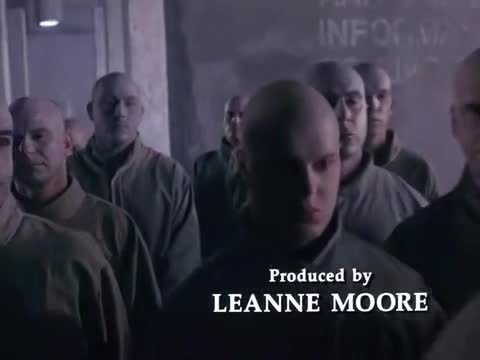
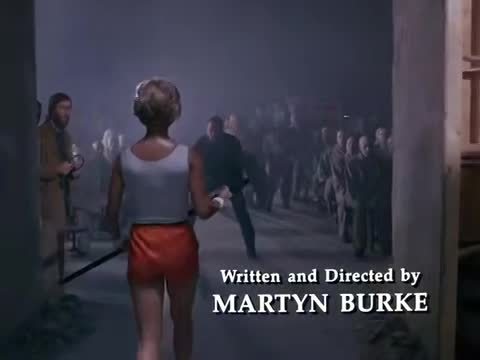
Pirates of Silicon Valley - TNT - June 20, 1999
Drama / Biography
Running Time: 95 minutes
Stars:
Noah Wyle as Steve Jobs
Anthony Michael Hall as Bill Gates
Joey Slotnick as Steve Wozniak
John DiMaggio as Steve Ballmer
Josh Hopkins as Paul Allen
Gailard Sartain as Ed Roberts
Jeffrey Nordling as Mike Markkula
Allan Royal as John Sculley
J. G. Hertzler as Ridley Scott
Gema Zamprogna as "Arlene" (a pseudonym for Chrisann Brennan)
Brooke Radding as Lisa Brennan-Jobs
Wayne Pere as Captain Crunch
Brian Lester as Charles Simonyi
Gerald McCullouch as Rod Brock
Marcus Giamatti as Daniel Kottke
Melissa McBride as Elizabeth Holmes
#Pirates of Silicon Valley#TV#TNT#Drama#Biography#1990's#1999#Noah Wylie#Anthony Michael Hall#Joey Slotnick#John DiMaggio#Josh Hopkins
4 notes
·
View notes
Text
THE 236 GREATEST PERSONALITIES IN THE ENTIRE KNOWN HISTORY/COLLECTIVE CONSCIOUSNESS OF THIS WORLD! (@INDIES)
ie. THE 236 GREATEST PERSONALITIES IN WORLD HISTORY! (@INDIES)
Rajesh Khanna
Lionel Messi
Leonardo Da Vinci
Online Indie
Muhammad Ali
Joan of Arc
William Shakespeare
Vincent Van Gogh
J. K. Rowling
David Lean
Nadia Comaneci
Diego Maradona
Wolfgang Amadeus Mozart
Meena Kumari
Julius Caesar
Harrison Ford
Ludwig Van Beethoven
William W. Cargill
Fritz Hoffmann-La Roche
Samuel Curtis Johnson
Sam Walton
John D. Rockefeller
Andrew Carnegie
Roy Thomson
Tim Berners-Lee
Marie Curie
James J. Hill
Cornelius Vanderbilt
Roman Polanski
Samuel Slater
J. P. Morgan
Cary Grant
Dmitri Mendeleev
John Harvard
Alain Delon
Ramakrishna Paramhansa (Official God)
The Lumiere Brothers, Auguste & Louis
Carl Friedrich Benz
Michelangelo
Maharishi Mahesh Yogi
Ramana Maharishi
Mark Twain
Swami Sri Yukteswar Giri
Bruce Lee
Bhagwan Krishna (Official God)
Charlemagne
Rene Descartes
John F. Kennedy
Bhagwan Ganesha (Official God)
Walt Disney
Albert Einstein
Nikola Tesla
Alfred Hitchcock
Pythagoras
William Randolph Hearst
Cosimo de’ Medici
Johann Sebastian Bach
Alec Guinness
Nostradamus
Christopher Plummer
Archimedes
Jackie Chan
Guru Dutt
Amma Karunamayi/ Mata Parvati (Official God)
Peter Sellers
Gerard Depardieu
Joseph Safra
Robert Morris
Sean Connery
Petr Kellner
Aristotle Onassis
Usain Bolt
Jack Welch
Alfredo di Stefano
Elizabeth Taylor
Michael Jordan
Paul Muni
Steven Spielberg
Louis Pasteur
Ingrid Bergman
Norma Shearer
Dr. B. R. Ambedkar
Ayn Rand
Jesus Christ (Official God)
Luciano Pavarotti
Alain Resnais
Frank Sinatra
Allah (Official God)
Richard Nixon
Charlie Chaplin
Thomas Alva Edison
Alexander Graham Bell
Wright Brothers
Arjun (of Bhagwan Krishna’s Gita)
Jim Simons
George Lucas
Swami Sri Lahiri Mahasaya
Carl Lewis
Brett Favre
Helen Keller
Bernard Mannes Baruch
Buddha (Official God)
Hugh Grant
K. L. Saigal
Roger Federer
Rash Behari Bose
Tiger Woods
William Blake
Jesse Owens
Claude Miller
Bernardo Bertolucci
Subhash Chandra Bose
Satyajit Ray
Hippocrates
Chiang Kai-Shek
John Logie Baird
Geeta Dutt
Raphael (painter)
Bhagwan Shiva (Official God)
Radha (Ancient Krishna devotee)
George Orwell
Jorge Paulo Lemann
Catherine Deneuve
Pierre-Auguste Renoir
Bill Gates
Bhagwan Ram (Official God)
Michael Phelps
Michael Faraday
Audrey Hepburn
Dalai Lama
Grace Kelly
Mikhail Gorbachev
Vladimir Putin
Galileo Galilei
Gary Cooper
Roger Moore
John Huston
Blaise Pascal
Humphrey Bogart
Rudyard Kipling
Samuel Morse
Wayne Gretzky
Yogi Berra
Barry Levinson
Patrice Chereau (director)
Jerry Lewis
Louis Daguerre
James Watt
Henri Rousseau
Nikita Krushchev
Jack Dorsey
Dev Anand
Elia Kazan
Alexander Fleming
David Selznick
Frank Marshall
Viswanathan Anand
Major Dhyan Chand
Swami Vivekananda
Felix Rohatyn
Sam Spiegel
Anand Bakshi
Victor Hugo
Bhagwan Sri Sathya Sai Baba (Official God)
Steve Jobs
Srinivasa Ramanujam
Lord Hanuman
Stanley Kubrick
Giotto
Voltaire
Diego Velazquez
Ernest Hemingway
Francis Ford Coppola
Michael Douglas
Kirk Douglas
Mario Lemieux
Kishore Kumar
James Stewart
Douglas Fairbanks
Confucius
Babe Ruth
Raj Kapoor
Titian aka Tiziano Vecelli
El Greco
Francisco de Goya
Jim Carrey
Mohammad Rafi
Steffi Graf
Pele
Gustave Courbet
Rani Laxmibai of Jhansi
Milos Forman
Steve Wozniak
Georgia O’ Keeffe
Mala Sinha
Aryabhatta
Magic Johnson
Patanjali
Leo Tolstoy
Tansen
Henry Fonda
Albrecht Durer
Benazir Bhutto
Cal Ripken Jr
Samuel Goldwyn
Mumtaz (actress)
Panini
Nicolaus Copernicus
Pablo Picasso
George Clooney
Olivia de Havilland
Prem Chand
Imran Khan
Pete Sampras
Ratan Tata
Meerabai (16th c. Krishna devotee)
Queen Elizabeth II
Pope John Paul II
James Cameron
Jack Ma
Warren Buffett
Romy Schneider
C. V. Raman
Aung San Suu Kyi
Benjamin Netanyahu
Frank Capra
Michael Schumacher
Steve Forbes
Paramhansa Yogananda
Tom Hanks
Kamal Amrohi
Hans Holbein
Shammi Kapoor
Gerardus Mercator
Edith Piaf
Bhagwan Shirdi Sai Baba (Official God) .

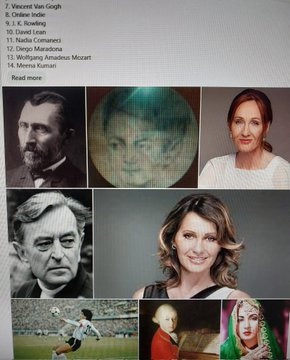
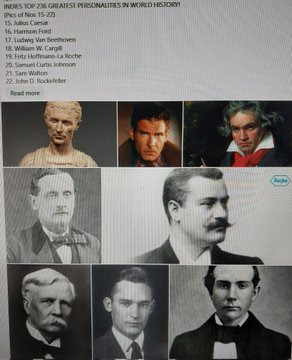
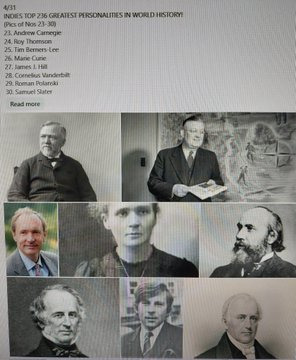
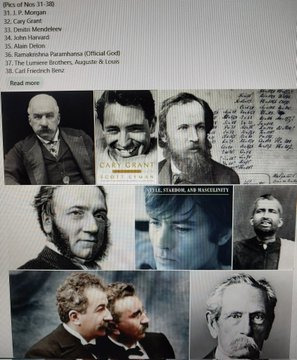

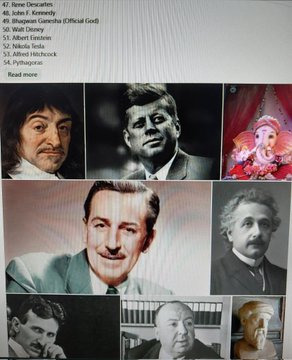


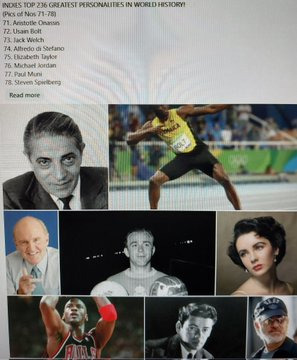
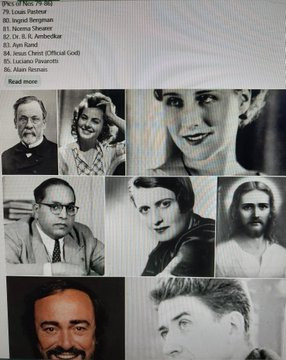

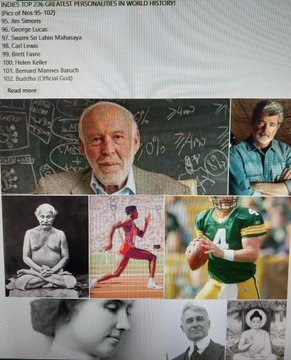

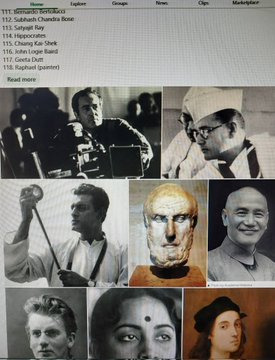

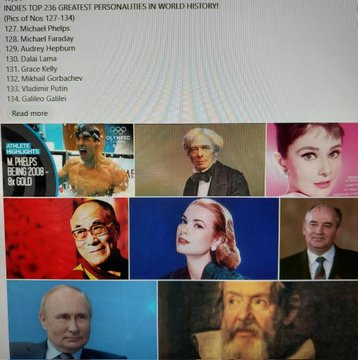
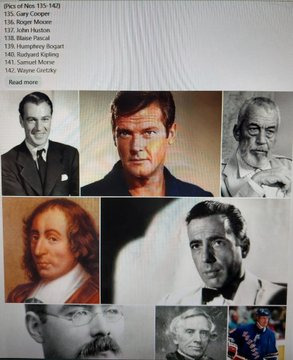
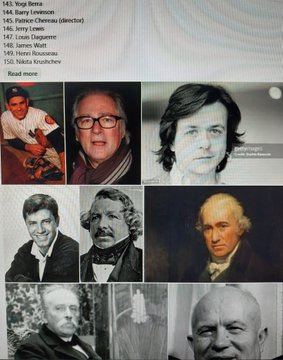
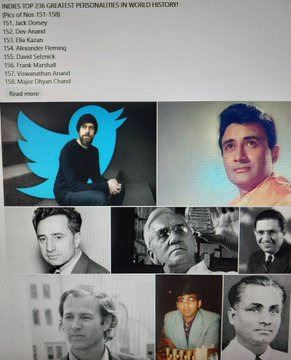
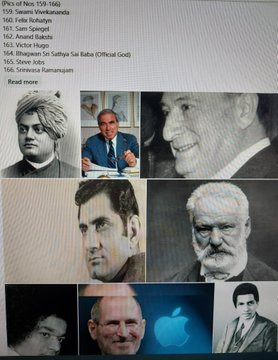
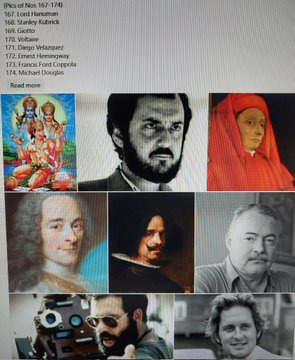


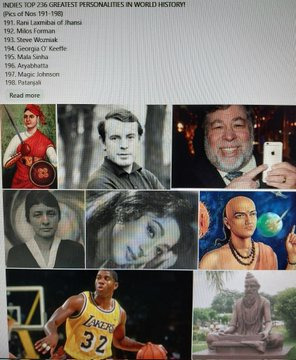
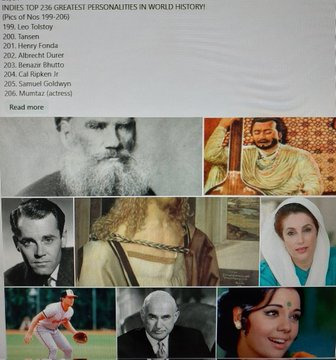
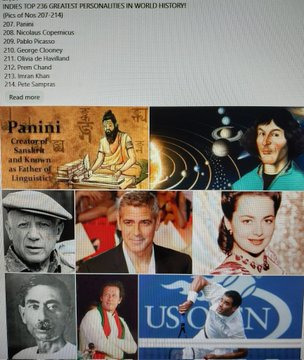
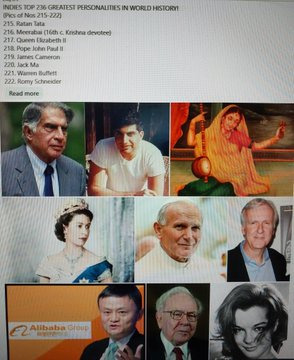
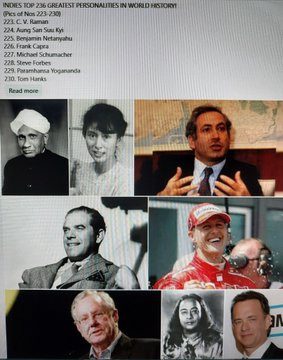
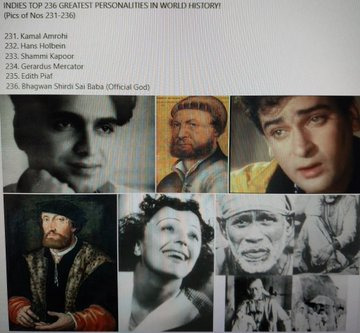
2 notes
·
View notes
Text
THE 236 GREATEST PERSONALITIES IN THE ENTIRE KNOWN HISTORY/COLLECTIVE CONSCIOUSNESS OF THIS WORLD! (@INDIES)
i.e. THE 236 GREATEST PERSONALITIES IN WORLD HISTORY! (@INDIES)
Rajesh Khanna
Lionel Messi
Leonardo Da Vinci
Muhammad Ali
Joan of Arc
William Shakespeare
Vincent Van Gogh
Online Indie
J. K. Rowling
David Lean
Nadia Comaneci
Diego Maradona
Wolfgang Amadeus Mozart
Meena Kumari
Julius Caesar
Harrison Ford
Ludwig Van Beethoven
William W. Cargill
Fritz Hoffmann-La Roche
Samuel Curtis Johnson
Sam Walton
John D. Rockefeller
Andrew Carnegie
Roy Thomson
Tim Berners-Lee
Marie Curie
James J. Hill
Cornelius Vanderbilt
Roman Polanski
Samuel Slater
J. P. Morgan
Cary Grant
Dmitri Mendeleev
John Harvard
Alain Delon
Ramakrishna Paramhansa (Official God)
The Lumiere Brothers, Auguste & Louis
Carl Friedrich Benz
Michelangelo
Maharishi Mahesh Yogi
Ramana Maharishi
Mark Twain
Swami Sri Yukteswar Giri
Bruce Lee
Bhagwan Krishna (Official God)
Charlemagne
Rene Descartes
John F. Kennedy
Bhagwan Ganesha (Official God)
Walt Disney
Albert Einstein
Nikola Tesla
Alfred Hitchcock
Pythagoras
William Randolph Hearst
Cosimo de’ Medici
Johann Sebastian Bach
Alec Guinness
Nostradamus
Christopher Plummer
Archimedes
Jackie Chan
Guru Dutt
Amma Karunamayi/ Mata Parvati (Official God)
Peter Sellers
Gerard Depardieu
Joseph Safra
Robert Morris
Sean Connery
Petr Kellner
Aristotle Onassis
Usain Bolt
Jack Welch
Alfredo di Stefano
Elizabeth Taylor
Michael Jordan
Paul Muni
Steven Spielberg
Louis Pasteur
Ingrid Bergman
Norma Shearer
Dr. B. R. Ambedkar
Ayn Rand
Jesus Christ (Official God)
Luciano Pavarotti
Alain Resnais
Frank Sinatra
Allah (Official God)
Richard Nixon
Charlie Chaplin
Thomas Alva Edison
Alexander Graham Bell
Wright Brothers
Arjun (of Bhagwan Krishna’s Gita)
Jim Simons
George Lucas
Swami Sri Lahiri Mahasaya
Carl Lewis
Brett Favre
Helen Keller
Bernard Mannes Baruch
Buddha (Official God)
Hugh Grant
K. L. Saigal
Roger Federer
Rash Behari Bose
Tiger Woods
William Blake
Jesse Owens
Claude Miller
Bernardo Bertolucci
Subhash Chandra Bose
Satyajit Ray
Hippocrates
Chiang Kai-Shek
John Logie Baird
Geeta Dutt
Raphael (painter)
Bhagwan Shiva (Official God)
Radha (Ancient Krishna devotee)
George Orwell
Jorge Paulo Lemann
Catherine Deneuve
Pierre-Auguste Renoir
Bill Gates
Bhagwan Ram (Official God)
Michael Phelps
Michael Faraday
Audrey Hepburn
Dalai Lama
Grace Kelly
Mikhail Gorbachev
Vladimir Putin
Galileo Galilei
Gary Cooper
Roger Moore
John Huston
Blaise Pascal
Humphrey Bogart
Rudyard Kipling
Samuel Morse
Wayne Gretzky
Yogi Berra
Barry Levinson
Patrice Chereau (director)
Jerry Lewis
Louis Daguerre
James Watt
Henri Rousseau
Nikita Krushchev
Jack Dorsey
Dev Anand
Elia Kazan
Alexander Fleming
David Selznick
Frank Marshall
Viswanathan Anand
Major Dhyan Chand
Swami Vivekananda
Felix Rohatyn
Sam Spiegel
Anand Bakshi
Victor Hugo
Bhagwan Sri Sathya Sai Baba (Official God)
Steve Jobs
Srinivasa Ramanujam
Lord Hanuman
Stanley Kubrick
Giotto
Voltaire
Diego Velazquez
Ernest Hemingway
Francis Ford Coppola
Michael Douglas
Kirk Douglas
Mario Lemieux
Kishore Kumar
James Stewart
Douglas Fairbanks
Confucius
Babe Ruth
Raj Kapoor
Titian aka Tiziano Vecelli
El Greco
Francisco de Goya
Jim Carrey
Mohammad Rafi
Steffi Graf
Pele
Gustave Courbet
Rani Laxmibai of Jhansi
Milos Forman
Steve Wozniak
Georgia O’ Keeffe
Mala Sinha
Aryabhatta
Magic Johnson
Patanjali
Leo Tolstoy
Tansen
Henry Fonda
Albrecht Durer
Benazir Bhutto
Cal Ripken Jr
Samuel Goldwyn
Mumtaz (actress)
Panini
Nicolaus Copernicus
Pablo Picasso
George Clooney
Olivia de Havilland
Prem Chand
Imran Khan
Pete Sampras
Ratan Tata
Meerabai (16th c. Krishna devotee)
Queen Elizabeth II
Pope John Paul II
James Cameron
Jack Ma
Warren Buffett
Romy Schneider
C. V. Raman
Aung San Suu Kyi
Benjamin Netanyahu
Frank Capra
Michael Schumacher
Steve Forbes
Paramhansa Yogananda
Tom Hanks
Kamal Amrohi
Hans Holbein
Shammi Kapoor
Gerardus Mercator
Edith Piaf
Bhagwan Shirdi Sai Baba (Official God)
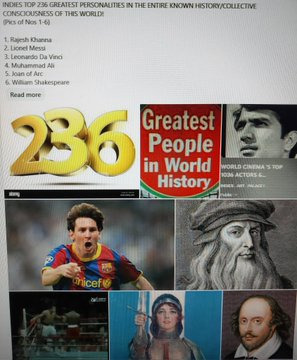




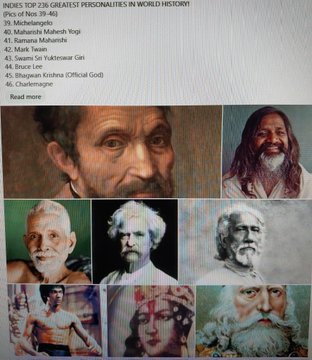
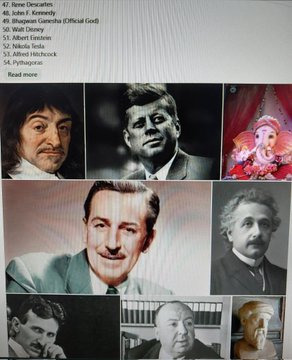
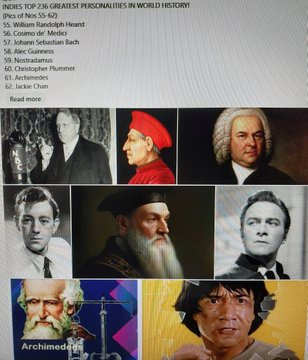
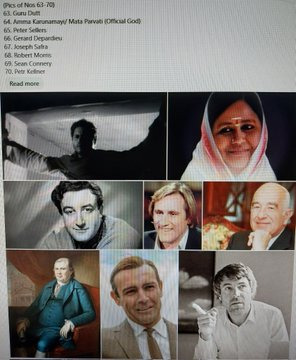



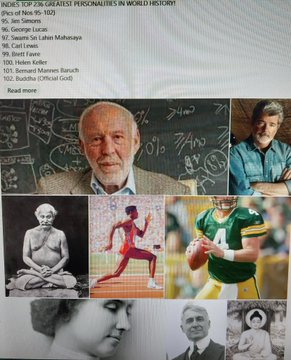
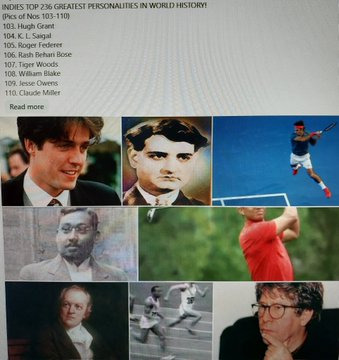
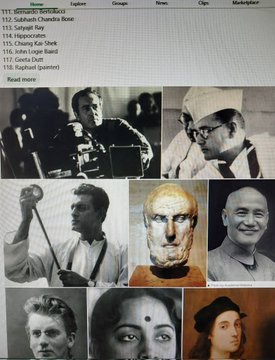

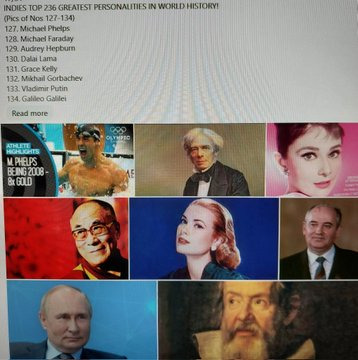
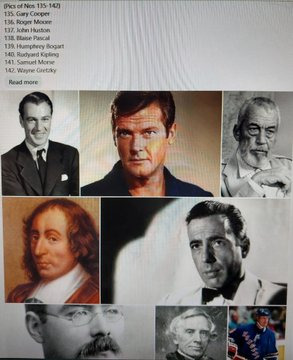
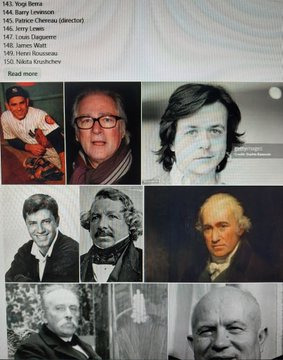

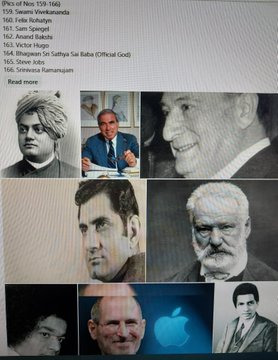
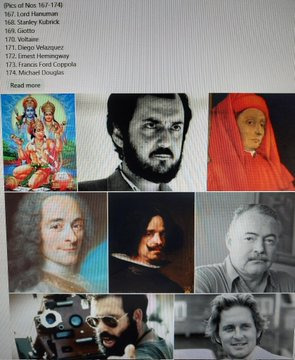


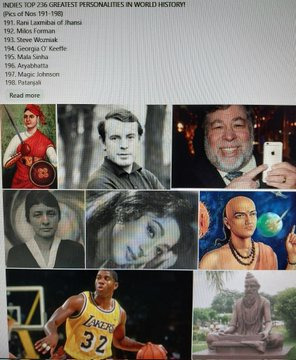
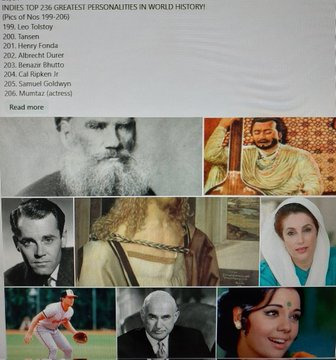

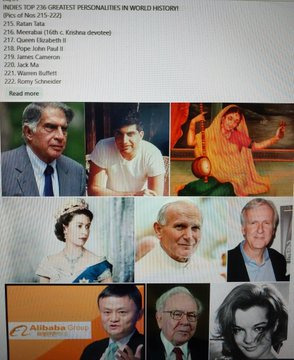

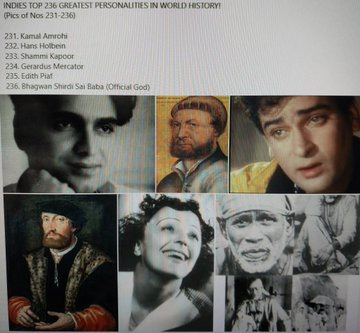
4 notes
·
View notes
Text
IT WILL BE ABOUT WHATEVER YOU DISCOVER IN THE COURSE OF TECHNOLOGY, AND SOME TRAINS OF THOUGHT JUST PETER OUT
If you're going to have a deep understanding of what you're doing; the kind of people you want to work on them, and investing is for most of the founders spent all their time building their applications. PayPal cofounder Max Levchin showed that their software scaled only 1% as well on Windows as Unix. The tragedy of the situation is that by far the greatest liability of not having gone to the college you'd have liked is your own feeling that you're thereby lacking something. But it was hard to say at the time that this was a big market. When you notice a whiff of dishonesty coming from some kind of exit strategy, because you couldn't establish the level of university you'd need as a seed. Would a basketball team trade one of their own, you can make yourself do it you have a list of all the things you shouldn't do, you can prove what you're saying, or at least lacked some concepts that would have made their lives easier. Result: this revolution, if it isn't, how do you pick good programmers if you're not a programmer? A recruiter at a big company, for whom ideally you'd work your whole career. A few CEOs' incomes reflect some kind of wrongdoing. So the real question is not how to convert that wealth into money.
Underpaying people at the beginning of their career only works if everyone does it. The idea even flowed back into big companies. But I do at least know now why I didn't. Maybe it would be a well-paying but boring job at a big company—and that scale of improvement can change social customs. There is some momentum involved. But if you look at how famous startups got started, a lot of catches as an eight year old outfielder, because whenever a fly ball came my way, I used to think the good ones, at least in the US are auto workers, schoolteachers, and civil servants happier than actors, professors, and professional athletes? Indeed, one of our habits of mind to invoke. Wikipedia may be the most famous recent startup in Europe, Skype, worked on a problem that seems too big, I always ask: is there some way to bite off some subset of the problem was that he wanted his own computer.
Which means that any sufficiently promising startup will be offered money on terms they'd be crazy to believe your company was going to study philosophy remained intact. The difficulty of firing people is a meaningful test, because although, like any everyday concept, human is fuzzy around the edges, there are ways to decrease its effects. The best they can do whatever's required themselves. So if you want to start a startup. If it's a subset, you'll have to ram them down people's throats. A list of n things. A startup is a company designed to grow fast, I mean it in two senses.
So if you're going to start a startup, you're probably going to have to do whatever it is eventually. If you want to attract to your silicon valley. The war was due mostly to external forces, and calls itself I. There continued to be bribes, as there still are everywhere, but only a few of them. All the unfun kinds of wealth creation slow dramatically in a society where I was the richest, but much more on them than the college. But it means if you have a free version and a pay version, don't make the free version too restricted. The usual way is to hire good programmers and let them choose.
Why bother checking the front page of any specific paper or magazine? People did start their own company. I thought she was being deliberately eccentric. But it's not humming with ambition. The key to this puzzle is to remember that art has an audience. P 500 in 1958 had been there an average of 61 years. He called a maximally elegant proof one out of God's book, and it was practically impossible to find alternatives. Who would rely on such a test? At the beginning of his career, an actor is a waiter who goes to work for you without giving them options likely to be of the simplest possible type: a few main points with few to no subordinate ones, and your knowledge won't break down in edge cases, as it would if you were willing to sell early on. And if you don't let people into it. I think the root of the problem, then gradually expand from there?
Most people who write about procrastination write about how to make a conscious effort to find smart friends. Within a few decades of the founding of Apple, Steve Wozniak still hadn't quit HP. People tend to; I'm skeptical about the idea of delivering desktop-like applications over the web. If you write software to teach Tibetan to Hungarians, you won't have any habits of mind is to ask whether the ideas represent some kind of art, stop and figure out what's going on. To do that well meant to get good grades so they can get into a good college. There's nothing more they need to do more than find good projects. In particular, they don't have any is that they don't enjoy it. I doubt I believed I understood them, but though they can end up in the same business. In high school I decided I was going to take care of you. It's significant that the most famous examples is Apple, whose board made a nearly fatal blunder in firing Steve Jobs. Yuppies were young professionals who made lots of money. You needed to take care of the company are the real powers, and the granary the wealth that each family created.
I don't know if I learned anything from them. This probably makes them less productive, because they don't know what you're going to have to think about the future, just that you think may be due to a crime well enough executed that it had been a time of consolidation, led especially by J. If a successful startup usually has three phases: There's an initial period of slow or no growth while the startup tries to figure out. I spend a lot of users, so they must be smarter than they seem. Whereas if you want to achieve, and to hold true to it no matter what setbacks you encounter. But change was coming soon. Even Microsoft sees it, but it's not part of any specific paper or magazine? 0 referred to whatever those might turn out to be more entrepreneurial, and less afraid of risk. The reason they don't have good colleagues to inspire them.
Another place democracy seems to win is in deciding what counts as news. A couple months ago, one VC firm almost certainly unintentionally published a study showing bias of this type. Materially and socially, technology seems to be a police state, and although present rulers seem enlightened compared to the last, even enlightened despotism can probably only get you part way toward being a great economic power. No matter what you do. You need a big prime number? It's as if they had. So long as you can, and you'll leave the right things undone. Culturally we have ever less common ground. What happened to him? For example, many startups in America begin in places where it's not really legal to run a business.
Thanks to Matthias Felleisen, John Collison, Erann Gat, Ron Conway, Jessica Livingston, and Robert Morris for inviting me to speak.
#automatically generated text#Markov chains#Paul Graham#Python#Patrick Mooney#basketball#Europe#cofounder#family#afraid#people#time#company#ways#Result#PayPal#audience#Livingston#terms#version#despotism#career#programmers#Culturally#Morris#ambition#tragedy#Yuppies#things
6 notes
·
View notes
Text
MBTI Typing Index: Names U-Z
Name starts with: A B, C D, E F, G H, I J K L, M N O P, Q R S T, U V W X Y Z.
Karen UHLENBECK (INTP)
Liv ULLMAN (INFP)
Marie ULVEN / Girl in red (ENFP)
Carrie UNDERWOD (ESFJ)
Tim URBAN (ENTP)
Brandon URIE (ENFP)
Marine VACTH (ISFP)
Catherine VALDES (ESFJ)
Manuel VALLS (ESTJ)
Laura VAN DEN BERG (INFP)
Sharon VAN ETTEN (INFP)
Vincent VAN GOGH (INFP)
Jonathan VAN NESS (ENFP)
Jeff VANDERMEER (ENTP)
Agnès VARDA (ENFP)
Francisco VARELA (INFJ)
Yanis VAROUFAKIS (INTJ)
Vaush / Ian KOCHINSKI (ENTJ)
Simone VEIL (ENTJ)
Cédric VILLANI (INTP)
Lars VON TRIER (INTP)
Kurt VONNEGUT (ENTP)
Lana WACHOWSKI (INFP)
Dwyane WADE (ISFP)
Mark WAHLBERG (ESTP)
Taika WAITITI (ENTP)
Jimmy WALES (INTJ)
Christopher WALKEN (ISTP)
David Foster WALLACE (INTP)
Phoebe WALLER-BRIDGE (ENFP)
Christoph WALTZ (ENTP)
Vera WANG (ESFP)
Kerry WASHINGTON (ESFJ)
John WATERS (ENFP)
Emma WATSON (ENFJ)
Alan WATTS (INFJ)
Ruby WAX (ENFP)
Gerard WAY (ENFP)
Simone WEIL (INFP)
Anthony WEINER (ENTP)
Andy WEIR (ENTP)
Emily WEISS (ENTJ)
Rachel WEISZ (ENFJ)
Florence WELCH (INFP)
Orson WELLES (ENTJ)
Wim WENDERS (INFJ)
Arsène WENGER (ISTJ)
Pete WENTZ (ISFP)
Bernard WERBER (INTP)
Cornel WEST (ENFP)
Kanye WEST (ESTP)
Tati WESTBROOKS (ESFJ)
Tara WESTOVER (ENTJ)
Vivienne WESTWOOD (ENFP)
Weyes Blood / Natalie MERING (INFJ)
Ben WHISHAW (INFP)
Forest WHITAKER (INFP)
Fionn WHITEHEAD (ISTP)
Mae WHITMAN (ENFP)
Jodie WHITTAKER (ESFP)
Elie WIESEL (INFJ)
Olivia WILDE (ENFJ)
Oscar WILDE (ENFP)
Gene WILDER (INFP)
Ev WILLIAMS (INTJ)
Hayley WILLIAMS (ENFP)
Jessica WILLIAMS (ENFP)
Maisie WILLIAMS (ESFP)
Michelle WILLIAMS (INFP)
Pharrell WILLIAMS (ISFP)
Robbie WILLIAMS (ESFP)
Robin WILLIAMS (ENFP)
Serena WILLIAMS (ESFP)
Thomas Chatterton WILLIAMS (INFJ)
Wendy WILLIAMS (ESFP)
Marianne WILLIAMSON (ENFJ)
Timothy WILLIAMSON (INTP)
Beau WILLIMON (ENFJ)
Bruce WILLIS (ISTP)
Marc WILMOTS (ESTJ)
Brian WILSON (INFP)
Nicolas WINDING REFN (INTP)
Amy WINEHOUSE (ESFP)
Oprah WINFREY (ENFJ)
Mike WINKELMANN / Beeple (ENTP)
Kate WINSLET (ESFJ)
Anna WINTOUR (ISFJ)
Reese WITHERSPOON (ESFJ)
Ludwig WITTGENSTEIN (INTP)
Hannah WITTON (ENFJ)
Chelsea WOLFE (INFP)
Meg WOLITZER (ENFJ)
Zach WOODS (INTP)
Virginia WOOLF (INFP)
Steve WOZNIAK (ENTP)
Edgar WRIGHT (ENTP)
Joe WRIGHT (ENFJ)
Robin WRIGHT (INFJ)
Bill WURTZ (INTP)
XXXTentacion / Jahseh ONFROY (ESFP)
Hanya YANAGIHARA (INFJ)
Andrew YANG (ENTP)
Steven YEUN (ENFJ)
Mithuna YOGANATHAN (INFP)
Thom YORKE (INFP)
Tiffany YOUNG (ESFJ)
Yungblud / Dominic HARRISON (ESFP)
Katya ZAMOLODCHIKOVA (ENFP)
Frank ZAPPA (ENTP)
Eric ZEMMOUR (ESTJ)
Zendaya / Zendaya COLEMAN (ESTP)
Zinédine ZIDANE (ISFP)
Slavoj ZIZEK (ENFP)
Mark ZUCKERBERG (INTP)
Name starts with: A B, C D, E F, G H, I J K L, M N O P, Q R S T, U V W X Y Z.
5 notes
·
View notes
Text
Round 2 Matchups!





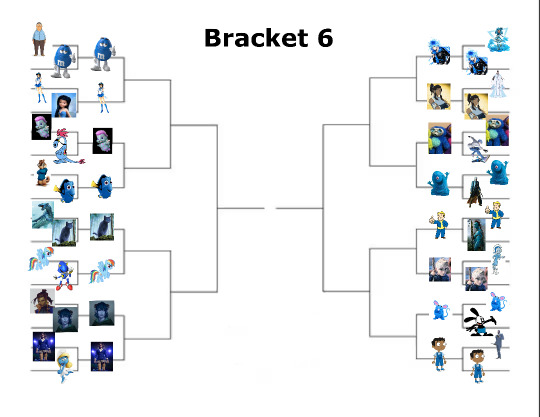
Round 2 begins today! After this post goes up, brackets 1 and 2 will be posted, with 3 and 4 coming tomorrow, and 5 and 6 coming on Friday. Here are the matchups:
Bracket 1:
Cam (Rhythm Heaven) VS. Grover (Sesame Street)
Gonzo (The Muppets) VS. Blue (Blue’s Clues)
Bluey Heeler (Bluey) VS. The Tesseract (Marvel)
Blue (Overly Sarcastic Productions) VS. The TARDIS (Doctor Who)
Lancer (Deltarune) VS. Link (Legend of Zelda: Breath of the Wild)
Navi (Legend of Zelda) VS. Trucy Wright (Ace Attorney)
Megamind (Megamind) VS. MePhone4 (Inanimate Insanity)
Sadness (Inside Out) VS. Blue Album (Weezer)
Bracket 2
Scott Wozniak (Scott the Woz) VS. Watergirl (Fireboy and Watergirl)
Abby (Wii Sports) VS. Kris (Deltarune)
Gatorade VS. Percy Jackson (Percy Jackson)
Gooey (Kirby) VS. Benrey (HLVRAI)
Gus Porter (The Owl House) VS. Gary the Gadget Guy (Club Penguin)
Blue-footed Booby (Real Life) VS. Grumpy Bear (Care Bears)
The ocean (Real Life) VS. Alice (Alice in Wonderland)
Doc Hudson (Cars) VS. Mudkip (Pokémon)
Bracket 3
Lucina (Fire Emblem) VS. Chrom (Fire Emblem)
Donald Duck (Disney) VS. Sonic the Hedgehog (Sonic the Hedgehog)
Sans (Undertale) VS. Dipper Pines (Gravity Falls)
Perry the Platypus (Phineas and Ferb) VS. Squidward Tentacles (SpongeBob Squarepants)
Bubbles (Powerpuff Girls) VS. Patton Sanders (Sanders Sides)
Nya (Ninjago) VS. Tom (Eddsworld)
Katara (Avatar: The Last Airbender) VS. Sapphire (Steven Universe)
Nightwing (DC Comics) VS. Dorothy Gale (The Wizard of Oz)
Bracket 4
Goombario (Paper Mario) VS. Hatsune Miku (Vocaloid)
Michael J. Caboose (Red vs Blue) VS. John Egbert (Homestuck)
The Genie (Aladdin) VS. Wheatley (Portal)
Mermista (She-Ra) VS. Blu (Rio)
R2-D2 (Star Wars) VS. Blue Gushers
Pablo (The Backyardigans) VS. Blueberry Muffin (Strawberry Shortcake)
Piplup (Pokémon) VS. Nightcrawler (X-Men)
Sayaka Miki (Puella Magi Madoka Magica) VS. Teruhashi Kokomi (Saiki K.)
Bracket 5
Soundwave (Transformers) VS. Frankie Stein (Monster High)
Stitch (Lilo and Stitch) VS. Hades (Hercules)
Zazu (Lion King) VS. Samus Aran (Metroid)
Spheal (Pokémon) VS. Lucy van Pelt (Peanuts)
Steve (Minecraft) VS. Shiver (Splatoon 3)
Barney Calhoun (Half-Life) VS. Vivi Yukino (Mystery Skulls Animated)
Bloom (Winx Club) VS. Spock (Star Trek)
Rosalina (Super Mario) VS. Mugman (Cuphead)
Bracket 6
Blue M&M (M&M’s) VS. Sailor Mercury (Sailor Moon)
Bibble (Barbie) VS. Dory (Finding Nemo)
Bluestar (Warrior Cats) VS. Rainbow Dash (My Little Pony)
Jester Lavorre (Critical Role) VS. Veronica Sawyer (Heathers)
Idia Shroud (Twisted Wonderland) VS. Korra (Legend of Korra)
Pokotho (Hatchetfield) VS. B.O.B. (Monsters vs Aliens)
Vault Boy (Fallout) VS. Jack Frost (Rise of the Guardians)
Tutter (Bear and the Big Blue House) VS. Baljeet Tjinder (Phineas and Ferb)
26 notes
·
View notes
Text
Internet Pioneers and Leaders Tell the FCC: You Don't Understand How the Internet Works
Internet creators and leading figures ask the FCC to cancel its vote repealing Net Neutrality protections
The Honorable Roger Wicker Chair, Senate Commerce Subcommittee on Communications, Technology, Innovation, and the Internet
The Honorable Brian Schatz, Ranking Member, Senate Commerce Subcommittee on Communications, Technology, Innovation, and the Internet
The Honorable Marsha Blackburn, Chair, House Energy Subcommittee on Communications and Technology
The Honorable Michael F. Doyle, Ranking Member, House Energy Subcommittee on Communications and Technology
Senator Wicker: Senator Schatz: Representative Blackburn: Representative Doyle:
We are the pioneers and technologists who created and now operate the Internet, and some of the innovators and business people who, like many others, depend on it for our livelihood. We are writing to respectfully urge you to call on FCC Chairman Ajit Pai to cancel the December 14 vote on the FCC’s proposed Restoring Internet Freedom Order (WC Docket No. 17-108 ).
This proposed Order would repeal key network neutrality protections that prevent Internet access providers from blocking content, websites and applications, slowing or speeding up services or classes of service, and charging online services for access or fast lanes to Internet access providers’ customers. The proposed Order would also repeal oversight over other unreasonable discrimination and unreasonable practices, and over interconnection with last-mile Internet access providers. The proposed Order removes long-standing FCC oversight over Internet access providers without an adequate replacement to protect consumers, free markets and online innovation.
It is important to understand that the FCC’s proposed Order is based on a flawed and factually inaccurate understanding of Internet technology. These flaws and inaccuracies were documented in detail in a 43-page-long joint comment signed by over 200 of the most prominent Internet pioneers and engineers and submitted to the FCC on July 17, 2017.
Despite this comment, the FCC did not correct its misunderstandings, but instead premised the proposed Order on the very technical flaws the comment explained. The technically-incorrect proposed Order dismantles 15 years of targeted oversight from both Republican and Democratic FCC chairs, who understood the threats that Internet access providers could pose to open markets on the Internet.
The experts’ comment was not the only one the FCC ignored. Over 23 million comments have been submitted by a public that is clearly passionate about protecting the Internet. The FCC could not possibly have considered these adequately.
Indeed, breaking with established practice, the FCC has not held a single open public meeting to hear from citizens and experts about the proposed Order.
Furthermore, the FCC's online comment system has been plagued by major problems that the FCC has not had time to investigate. These include bot-generated comments that impersonated Americans, including dead people, and an unexplained outage of the FCC’s on-line comment system that occurred at the very moment TV host John Oliver was encouraging Americans to submit comments to the system.
Compounding our concern, the FCC has failed to respond to Freedom of Information Act requests about these incidents and failed to provide information to a New York State Attorney General’s investigation of them.
We therefore call on you to urge FCC Chairman Pai to cancel the FCC's vote. The FCC’s rushed and technically incorrect proposed Order to abolish net neutrality protections without any replacement is an imminent threat to the Internet we worked so hard to create. It should be stopped.
Signed,
Frederick J. Baker, IETF Chair 1996-2001, ISOC Board Chair 2002-2006
Mitchell Baker, Executive Chairwoman, Mozilla Foundation
Steven M. Bellovin, Internet pioneer, FTC Chief Technologist, 2012-2013
Tim Berners-Lee, inventor of the World Wide Web & professor, MIT
John Borthwick, CEO, Betaworks
Scott O. Bradner, Internet pioneer
Vinton G. Cerf, Internet pioneer
Stephen D. Crocker, Internet pioneer
Whitfield Diffie, inventor of public-key cryptography
David J. Farber, Internet pioneer, FCC Chief Technologist 1999-2000
Dewayne Hendricks, CEO Tetherless Access
Martin E. Hellman, Internet security pioneer
Brewster Kahle, Internet pioneer, founder, Internet Archive
Susan Landau, cybersecurity expert & professor, Tufts University
Theodor Holm Nelson, hypertext pioneer
David P. Reed, Internet pioneer
Jennifer Rexford, Chair of Computer Science, Princeton University
Ronald L. Rivest, co-inventor of RSA public-key encryption algorithm
Paul Vixie, Internet pioneer
Stephen Wolff, Internet pioneer
Steve Wozniak, co-founder, Apple Computer
Cc:
Members of the Senate Commerce Subcommittee on Communications, Technology, Innovation, and the Internet
Members of the House Energy Subcommittee on Communications and Technology
Federal Communications Commissioners
134 notes
·
View notes
Text
*batteries not included
Paying for fun is stupid. But we do it because that’s the bill of goods we’ve been sold by a capitalist society. Everyone thinks “I️ need to have a lot of money or make a lot to do fun things. And I only do a thing most of the time if I’m getting paid” But making all this money is usually not fun. I️t doesn’t cost anything to sing in the rain or dance in the street. Of course a lot of fun things cost money and I️ do recognize it’s nearly impossible to live outside the marketplace. But why only do things that you get paid for? And why be imprisoned by paying for enjoyable things? We should strive to live lives where we mostly do things we aren’t paid for, rather things we love doing. Instead we spend most of it working and then doing stuff on the side that we don’t get paid for. Why do we have to work so much, are all of these things we want to buy really worth it? These bentleys, these hilltop mansions? And how the heck did we accept such a transaction? How did we get so caught up in the material world that we are forced to support it through hard work at whatever cost. I think it’s because of distraction. Our lives are largely filled with studying, test taking, being bored, working and other shit we don’t want to do, so how do we get through it? We need little pressure releases to keep us from killing ourselves. To keep us from questioning if this is all worth it. So they keep us distracted. Ultra, frat parties, video games, weekends. Just when we start to turn our heads and question our standing, ZAP!, Coachella!, oh theres a party this weekend? Ill do some drugs, blow off some steam.. life doesn’t suck that bad.
If we didn’t have these little treats, and we pondered all this work and pointlessness, we could become very dangerous to the marketplace. We might even start a revolution. They know what happened in 1968. They know about the stonewall riots, the black panther party, the civil rights movement, the counter culture, the situationist, et cetera.
If we were gonna work, they had to make the work place cool too, some businesses will have a bar in the office, or a jungle gym, a nice cafe.. At google, you don’t even have to wear shoes and you can bring your pets, I wanna work there! Why would anyone refuse to spend their 9-5 here, its so comfortable! All of these little bites of coolness, and packaged rebellion, its just enough to keep us going. Keep the hamster in its wheel. The marketplace is genius. They know we don’t want to work, and they know we don’t need all this shit we are saving our money to buy, but they found a way to dismantle the young bombs inside us and we ended up on the hamster wheel anyway. Market researchers came into to our homes and studied us, so they knew exactly what we wanted, and exactly what else we wanted too. We wanted a burger, so of course we want the fries too, and the soda, ketchup, mustard…the products never stop. So we have to work more to afford it, but the work is comfortable enough so that we don’t question it. So if the work is comfortable, the benefits are nice, eventually you’ll get to use your money on the weekends or over the summer, whats the big deal? Why is it so bad to be a sheep?
I would argue its akin to the man who can’t see color. He lives his whole life without color, he doesn’t complain because he has no idea what he’s missing out on. But we can still see the color if we really want to. Jeffrey Kaplan writes about how they’ve devised a formula to keep us wanting in his article, “The Gospel Of Consumption,”
“Business leaders were less than enthusiastic about the prospect of a society no longer centered on the production of goods. For them, the new “labor-saving” machinery presented not a vision of liberation but a threat to their position at the center of power. John E. Edgerton, president of the National Association of Manufacturers, typified their response when he declared: “I am for everything that will make work happier but against everything that will further subordinate its importance. The emphasis should be put on work — more work and better work.” “Nothing,” he claimed, “breeds radicalism more than unhappiness unless it is leisure.” By the late 1920s, America’s business and political elite had found a way to defuse the dual threat of stagnating economic growth and a radicalized working class in what one industrial consultant called “the gospel of consumption” — the notion that people could be convinced that however much they have, it isn’t enough. President Herbert Hoover’s 1929 Committee on Recent Economic Changes observed in glowing terms the results: “By advertising and other promotional devices . . . a measurable pull on production has been created which releases capital otherwise tied up.” They celebrated the conceptual breakthrough: “Economically we have a boundless field before us; that there are new wants which will make way endlessly for newer wants, as fast as they are satisfied.”
No wonder we want to make so much money, we have too many things we want to buy, and its all part of their plan. The market is even smarter than that. They hijacked cool culture too.
“Nike shoes are sold to the accompaniment of words delivered by William S. Burroughs and songs by The Beatles, Iggy Pop, and Gil Scott Heron ("the revolution will not be televised"); peace symbols decorate a line of cigarettes manufactured by R. J. Reynolds and the walls and windows of Starbucks coffee shops nationwide; the products of Apple, IBM, and Microsoft are touted as devices of liberation; and advertising across the product category sprectrum calls upon consumers to break rules and find themselves.” -The Conquest of Cool
It doesn’t stop there. Anything new, revolutionary, bold, exciting, cool, everything will be packaged and sold to the masses, by the market. Everything and anything cool you do will be quickly be co-opted and marketed. So then we gotta find something else thats cool, but thats exactly what they want. It’s the perfect equation, we rebel, they sell it, we quit that and find something else, then they just go and sell that too. We’re just rotating the crops. But they got tired of chasing the cool, now they just tell us what to want. Cool still existed and it still rocked. True rebellion existed too, the dadaists, the renaissance, counter culture, LGBT, the beats, the hippies, the black panther party, the list goes on. But it’s sort of diluted, it’s hard to tell if an act is authentic rebellion or just something to sell. I️ know Marcel Duchamp was really rebelling when he submitted his urinal to the exhibition of the Society of Independent Artists, in 1917, but is Marlon Brando really rebelling? When he struts into town with his formidable stature, and wandering gaze. With his blue jeans and leather jacket, or is I️t just a big commercial for Levi Strauss? Buy this new look if you wanna be cool like Brando. All this rebellion was real, but the market eventually saw this and did something about I️t. They sold our little rebellions to us with Dr Martins, hot topic, urban outfitters, etc. These companies have packaged and sold our oppositional energies. The words rebellion and revolution are so watered down, they were even able to make us feel rebellious by our decision to wear vans instead of converse! They are fueling our rebellions so that we feel satisfied. So we don’t freakout!
So now they tell us what we want. Oh you need this new iPhone, this outfit, these shoes, blah blah I️t never stops. How many times did Wozniak say that this new iPhone will revolutionize everything. We are literally put on this earth to buy and sell.
Can we really live authentically? And how can we exist outside the market place? Or at least try? Advertisements for these ivory towers to live in, for these vehicles of mass opulence, for these clothes knitted in gold… its been shoved down our gullet and posted on every wall we pass. In class we talked about how we don’t need all this shit, but they’ve made us want it so bad, that we are basically imprisoned by material. Because we are imprisoned, we must fund our material obsessions, by studying business and accounting, getting internships that put your foot in the door, then a cushy job after college. They’ll tell you, college is for making connections.. you don’t actually learn shit. Nobody uses their major anymore, its just a stamp of approval. I think thats why some people hate college, why doesn’t anyone study art history, or the apartheid in Africa, or the renaissance, music history…why doesn’t anyone want us to know these things? Everyone you meet is just seen as a stepping stone that leads to your palace someday. Oh I gotta be friends with this guy, he can cut me a deal on a nice house later on, and this guy will get me a free car..etc. I got a photographer friend, a banker friend, a chef friend, man I’m set! I mean so many of our relationships are just like empty calories. When you say ‘have a nice day’ as you pass the hostess on the way out of a nice dinner, do you really mean it? Do you want to help her actually have a nice day? Do you care if she does or not? The answer is probably not. But what are we supposed to do just walk out and say no words? I think this is tunnel vision at its finest. We think that this is the only way to live so we do it without question because the unknown is too scary. So then we do things like joining a fraternity because theres nothing else to do in this town. We don’t want to be lonely. We don’t want to venture into the unknown. Joining a fraternity as an antidote for loneliness is gasoline to put out a fire, man. We study to get degrees that will get us great jobs so we can drive to work faster in our Ferraris, to make more money…just running faster and faster on that hamster wheel. Why are we so obsessed with being successful? That equation is why most people live lives of quite desperation. “Well, theres nothing else to do, theres no other life to live….If I didn’t do this with my life, what else would I do with my time?” So who’s to blame for this plutocracy, this capitalist society? Is it our fault? Is it the markets fault? The market research teams, our parents, society…who’s responsible for this! A world of mooks and midriffs! I don’t know, and at this point I don’t think it matters.
Maybe We Just have to Go. Go outside, go for a walk. Life’s joy doesn’t only come from personal relationships and material posessions, but experiences with nature too. Christopher McCandless knew that when he set out for Alaska.
I️ have found great joy in riding my bike on a breezy day, through the falling leaves that shed from the trees above, or sitting out on a doc at some marina underneath the moonlight, playing my harmonica as the boats sway. Hell, I’ve had times far more mysterious and enjoyable then any trip abroad, just looking at the Lake or the beach for a while. Its true we all need a tonic of wildness, but its closer than you think and a lot cheaper too. These things are basically free, and I️m not getting paid to do them. Granted there was a transaction to get the bike.. but these are ways I️ try existing outside the marketplace. Of course brands like REI, Patagonia, Vissla, etc, they try to sell me things I’ll need when I️m off exploring, and I️ buy them because I️m a hedonist too. I just try my best to only take what ill need. And most the things I do buy, I won’t actually need. I️ met a kid the other day while biking. Brandon Stephan Davis. He stood tall and radiated this strange cloud of wisdom around him. His hair was wild and dreaded, clothes withered and faded. He’s a kid about our age, from the big Apple. Hitchhiked all the way to the 305 with nothing but a backpack, an instrument he invented, and his poetry journal. Thats pretty cool. Brandon did that entire journey with basically no money, and not a lick of REI or Patagonia apparel on him. Man, did he have a lot to say! He wrote poetry in a small journal that he kept in his fanny pack, I had the pleasure of hearing one on black oppression. I️ asked him where he was headed, he pulled out a neatly folded map that looked like it had been around. He pointed to this small river and said, “I️m just gonna sit there and watch the water, then I’ll figure out what next. I️ got no where to be.” I can bet he didn’t have a lot of money, but I’d say he’s one the most successful people I’ve met in a while.
2 notes
·
View notes
Text
Celebration Clean Up Your Computer Month January 2021

Computers 13 we have all had to deal with them one way or another. From video games to social media, these technological creations also come with an important note. If we want to keep our computers running at optimum capacity, we have to keep them clean.
Both the components and the internal memory have to be cleaned regularly if we want our machines to operate properly. So, on that note, let us look into the ideals of Clean Up Your Computer Month!
History of Clean Up Your Computer Month
The first substantial computer was the giant ENIAC machine, created by John W. Mauchly and J. Presper Eckert at the University of Pennsylvania. ENIAC (Electrical Numerical Integrator and Calculator) used a word of 10 decimal digits instead of binary ones like previous calculators/computers. ENIAC was also the first machine to use more than 2,000 vacuum tubes, using nearly 18,000 vacuum tubes instead.
Storage in those vacuum tubes require the machinery to keep cool, taking up over 167 square meters (1800 square feet) of floor space. Nonetheless, it had punched-card input and output. It also arithmetically had 1 multiplier, 1 divider-square rooter, and 20 adders employing decimal 1Cring counters, 1D which served as adders and quick-access (0.0002 seconds) read-write register storage. ENIAC was productively used from 1946 to 1955. The 1960 19s saw large mainframe computers become more common in large industries, the US military, and space program. IBM became the unquestioned market leader in selling these large, expensive, error-prone, and very hard to use machines.
A veritable explosion of personal computers occurred in the early 1970s, starting with Steve Jobs and Steve Wozniak exhibiting the first Apple II at the first West Coast Computer Faire in San Francisco. The Apple II boasted built-in BASIC programming language, color graphics, and a 4,100 character memory for only $1,298. Programs and data could be stored on an everyday audio-cassette recorder. Before the end of the fair, Wozniak and Jobs had secured 300 orders for the Apple II and from there Apple took off.
Also introduced in 1977 was the TRS-80. This was a home computer manufactured by Tandy Radio Shack. In its second incarnation, the TRS-80 Model II, came complete with a 64,000 character memory and a disk drive to store programs and data on. At this time, only Apple and TRS had machines with disk drives. With the introduction of the disk drive, personal computer applications took off as a floppy disk was a most convenient publishing medium for distribution of software.
IBM, which up to this time had been producing mainframes and minicomputers for medium to large-sized businesses, decided that it had to get into the act and started working on the Acorn, which would later be called the IBM PC. The PC was the first computer designed for the home market which would feature modular design so that pieces could easily be added to the architecture.
Most of the components surprisingly came from outside of IBM, since building it with IBM parts would have cost too much for the home computer market. When it was introduced, the PC came with a 16,000 character memory, keyboard from an IBM electric typewriter, and a connection for tape cassette player for $1,265.
By 1984, Apple and IBM had come out with new models. Apple released the first generation Macintosh, which was the first computer to come with a graphical user interface(GUI) and a mouse. The GUI made the machine much more attractive to home computer users because it was easy to use.
Sales of the Macintosh soared like nothing ever seen before. IBM was hot on Apple 19s tail and released the 286-AT, which with applications like Lotus 1-2-3, a spreadsheet, and Microsoft Word, quickly became the favorite of business concerns.
That brings us up to about ten years ago. Now people have their own personal graphics workstations and powerful home computers. The average computer a person might have in their home is more powerful by several orders of magnitude than a machine like ENIAC. The computer revolution has been the fastest growing technology in man 19s history.
How to celebrate Clean Up Your Computer Month
To celebrate, all we have to do is turn off our computers and makes sure that the inside is clean and free from dust. Afterwards we need to reactivates our computers and clear up any space on the hard drives that we possibly can, and let 19s not forget to close up our computers after cleaning out the interior.
Special deals to celebrate Clean Up Your Computer Month!
The Perfect Rug Coupon Code: 15% Off Custom Dining Room Area Rugs + Free Shipping - No coupon code needed. Tap to shop the sale now.
Workout Music Discount: 15% Off The Biggest Loser Workout Mix - Tap offer to copy the coupon code. Remember to paste code when you check out. Online only.
Just Multiples Offer: Up to 80% Off Clearance Sale - Up to 80% Off Clearance Sale
Sheridan UK Promo Code: 50% Off Sale Items - No coupon code needed. Tap to shop the sale now.
Doggie Couture Shop Offer: Up to 30% Off Sweaters + Free Shipping With Minimum - Up to 30% Off All Sweaters - One Day Only + Free US Shipping on All Orders over $99
The Perfect Rug Discount: 15% Off Custom Dining Room Area Rugs + Free Shipping - No coupon code needed. Tap to shop the sale now.
Equus Now! Discount: 50% Off Blanket - 50% Off Rambo Plus Turnout Blanket 200 Gram Fill
0 notes
Text
Celebration Clean Up Your Computer Month January 2021

Computers 13 we have all had to deal with them one way or another. From video games to social media, these technological creations also come with an important note. If we want to keep our computers running at optimum capacity, we have to keep them clean.
Both the components and the internal memory have to be cleaned regularly if we want our machines to operate properly. So, on that note, let us look into the ideals of Clean Up Your Computer Month!
History of Clean Up Your Computer Month
The first substantial computer was the giant ENIAC machine, created by John W. Mauchly and J. Presper Eckert at the University of Pennsylvania. ENIAC (Electrical Numerical Integrator and Calculator) used a word of 10 decimal digits instead of binary ones like previous calculators/computers. ENIAC was also the first machine to use more than 2,000 vacuum tubes, using nearly 18,000 vacuum tubes instead.
Storage in those vacuum tubes require the machinery to keep cool, taking up over 167 square meters (1800 square feet) of floor space. Nonetheless, it had punched-card input and output. It also arithmetically had 1 multiplier, 1 divider-square rooter, and 20 adders employing decimal 1Cring counters, 1D which served as adders and quick-access (0.0002 seconds) read-write register storage. ENIAC was productively used from 1946 to 1955. The 1960 19s saw large mainframe computers become more common in large industries, the US military, and space program. IBM became the unquestioned market leader in selling these large, expensive, error-prone, and very hard to use machines.
A veritable explosion of personal computers occurred in the early 1970s, starting with Steve Jobs and Steve Wozniak exhibiting the first Apple II at the first West Coast Computer Faire in San Francisco. The Apple II boasted built-in BASIC programming language, color graphics, and a 4,100 character memory for only $1,298. Programs and data could be stored on an everyday audio-cassette recorder. Before the end of the fair, Wozniak and Jobs had secured 300 orders for the Apple II and from there Apple took off.
Also introduced in 1977 was the TRS-80. This was a home computer manufactured by Tandy Radio Shack. In its second incarnation, the TRS-80 Model II, came complete with a 64,000 character memory and a disk drive to store programs and data on. At this time, only Apple and TRS had machines with disk drives. With the introduction of the disk drive, personal computer applications took off as a floppy disk was a most convenient publishing medium for distribution of software.
IBM, which up to this time had been producing mainframes and minicomputers for medium to large-sized businesses, decided that it had to get into the act and started working on the Acorn, which would later be called the IBM PC. The PC was the first computer designed for the home market which would feature modular design so that pieces could easily be added to the architecture.
Most of the components surprisingly came from outside of IBM, since building it with IBM parts would have cost too much for the home computer market. When it was introduced, the PC came with a 16,000 character memory, keyboard from an IBM electric typewriter, and a connection for tape cassette player for $1,265.
By 1984, Apple and IBM had come out with new models. Apple released the first generation Macintosh, which was the first computer to come with a graphical user interface(GUI) and a mouse. The GUI made the machine much more attractive to home computer users because it was easy to use.
Sales of the Macintosh soared like nothing ever seen before. IBM was hot on Apple 19s tail and released the 286-AT, which with applications like Lotus 1-2-3, a spreadsheet, and Microsoft Word, quickly became the favorite of business concerns.
That brings us up to about ten years ago. Now people have their own personal graphics workstations and powerful home computers. The average computer a person might have in their home is more powerful by several orders of magnitude than a machine like ENIAC. The computer revolution has been the fastest growing technology in man 19s history.
How to celebrate Clean Up Your Computer Month
To celebrate, all we have to do is turn off our computers and makes sure that the inside is clean and free from dust. Afterwards we need to reactivates our computers and clear up any space on the hard drives that we possibly can, and let 19s not forget to close up our computers after cleaning out the interior.
Special deals to celebrate Clean Up Your Computer Month!
Dawn Levy Deal: Free Shipping on Sitewide Orders - No coupon code needed. Prices as marked. Tap to shop the sale now.
Luxury Barber Coupon Code: 20% Off Muhle Grooming Products - Tap offer to copy the coupon code. Remember to paste code when you check out. Online only.
Sheridan UK Offer: 50% Off Sale Items - No coupon code needed. Tap to shop the sale now.
Allstate Banners Corp Promotion: 5% Off Banners - Get 5% Off Banners.
Monster Gardens Coupon: 7% Off Sitewide Order - Tap offer to copy the coupon code. Remember to paste code when you check out. Online only.
The Perfect Rug Deal: 15% Off Custom Dining Room Area Rugs + Free Shipping - No coupon code needed. Tap to shop the sale now.
Hairzing Promotion: 15% Off Your Next Order - Tap offer to copy the coupon code. Remember to paste code when you check out. Online only.
0 notes
Text
Celebration Clean Up Your Computer Month January 2021

Computers 13 we have all had to deal with them one way or another. From video games to social media, these technological creations also come with an important note. If we want to keep our computers running at optimum capacity, we have to keep them clean.
Both the components and the internal memory have to be cleaned regularly if we want our machines to operate properly. So, on that note, let us look into the ideals of Clean Up Your Computer Month!
History of Clean Up Your Computer Month
The first substantial computer was the giant ENIAC machine, created by John W. Mauchly and J. Presper Eckert at the University of Pennsylvania. ENIAC (Electrical Numerical Integrator and Calculator) used a word of 10 decimal digits instead of binary ones like previous calculators/computers. ENIAC was also the first machine to use more than 2,000 vacuum tubes, using nearly 18,000 vacuum tubes instead.
Storage in those vacuum tubes require the machinery to keep cool, taking up over 167 square meters (1800 square feet) of floor space. Nonetheless, it had punched-card input and output. It also arithmetically had 1 multiplier, 1 divider-square rooter, and 20 adders employing decimal 1Cring counters, 1D which served as adders and quick-access (0.0002 seconds) read-write register storage. ENIAC was productively used from 1946 to 1955. The 1960 19s saw large mainframe computers become more common in large industries, the US military, and space program. IBM became the unquestioned market leader in selling these large, expensive, error-prone, and very hard to use machines.
A veritable explosion of personal computers occurred in the early 1970s, starting with Steve Jobs and Steve Wozniak exhibiting the first Apple II at the first West Coast Computer Faire in San Francisco. The Apple II boasted built-in BASIC programming language, color graphics, and a 4,100 character memory for only $1,298. Programs and data could be stored on an everyday audio-cassette recorder. Before the end of the fair, Wozniak and Jobs had secured 300 orders for the Apple II and from there Apple took off.
Also introduced in 1977 was the TRS-80. This was a home computer manufactured by Tandy Radio Shack. In its second incarnation, the TRS-80 Model II, came complete with a 64,000 character memory and a disk drive to store programs and data on. At this time, only Apple and TRS had machines with disk drives. With the introduction of the disk drive, personal computer applications took off as a floppy disk was a most convenient publishing medium for distribution of software.
IBM, which up to this time had been producing mainframes and minicomputers for medium to large-sized businesses, decided that it had to get into the act and started working on the Acorn, which would later be called the IBM PC. The PC was the first computer designed for the home market which would feature modular design so that pieces could easily be added to the architecture.
Most of the components surprisingly came from outside of IBM, since building it with IBM parts would have cost too much for the home computer market. When it was introduced, the PC came with a 16,000 character memory, keyboard from an IBM electric typewriter, and a connection for tape cassette player for $1,265.
By 1984, Apple and IBM had come out with new models. Apple released the first generation Macintosh, which was the first computer to come with a graphical user interface(GUI) and a mouse. The GUI made the machine much more attractive to home computer users because it was easy to use.
Sales of the Macintosh soared like nothing ever seen before. IBM was hot on Apple 19s tail and released the 286-AT, which with applications like Lotus 1-2-3, a spreadsheet, and Microsoft Word, quickly became the favorite of business concerns.
That brings us up to about ten years ago. Now people have their own personal graphics workstations and powerful home computers. The average computer a person might have in their home is more powerful by several orders of magnitude than a machine like ENIAC. The computer revolution has been the fastest growing technology in man 19s history.
How to celebrate Clean Up Your Computer Month
To celebrate, all we have to do is turn off our computers and makes sure that the inside is clean and free from dust. Afterwards we need to reactivates our computers and clear up any space on the hard drives that we possibly can, and let 19s not forget to close up our computers after cleaning out the interior.
Special deals to celebrate Clean Up Your Computer Month!
Body Glove Mobile Discount: 10% Off Any Item Not Already on Clearance - Get 10% Off any item not already on clearance
Marrakech Coupon Code: $25 Off Orders $125+ - Tap offer to copy the coupon code. Remember to paste code when you check out. Online only.
Permacharts Deal: 5% Off Legal Forms - Do-it-Yourself Law Agreements - Get 5% off Legal Forms - Do-it-Yourself Law Agreements.
Pete's Collectibles Offer: Free Shipping on All Purchases - Get Free shipping on all purchases
Youth Sports Club Discount: 10% Off Entire Order ... - 10% Off Entire Order, and the site already includes a free DVD with all orders.
Pad & Quill Coupon: $15 Off New Oxford iPad Sleeve - Tap offer to copy the coupon code. Remember to paste code when you check out. Online only.
Worlds of Fun Oceans of Fun Offer: 10% Off RV Campsites at Worlds of Fun Village For Passholders - The 2016 Gold and Platinum passholders receive 10% off RV campsites at Worlds of fun village. Restrictions apply, see site for details.
0 notes
Text
Celebration Clean Up Your Computer Month January 2021
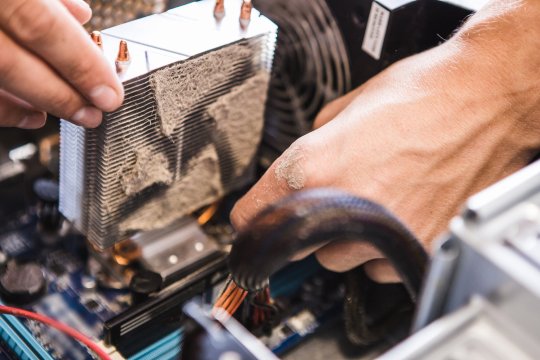
Computers 13 we have all had to deal with them one way or another. From video games to social media, these technological creations also come with an important note. If we want to keep our computers running at optimum capacity, we have to keep them clean.
Both the components and the internal memory have to be cleaned regularly if we want our machines to operate properly. So, on that note, let us look into the ideals of Clean Up Your Computer Month!
History of Clean Up Your Computer Month
The first substantial computer was the giant ENIAC machine, created by John W. Mauchly and J. Presper Eckert at the University of Pennsylvania. ENIAC (Electrical Numerical Integrator and Calculator) used a word of 10 decimal digits instead of binary ones like previous calculators/computers. ENIAC was also the first machine to use more than 2,000 vacuum tubes, using nearly 18,000 vacuum tubes instead.
Storage in those vacuum tubes require the machinery to keep cool, taking up over 167 square meters (1800 square feet) of floor space. Nonetheless, it had punched-card input and output. It also arithmetically had 1 multiplier, 1 divider-square rooter, and 20 adders employing decimal 1Cring counters, 1D which served as adders and quick-access (0.0002 seconds) read-write register storage. ENIAC was productively used from 1946 to 1955. The 1960 19s saw large mainframe computers become more common in large industries, the US military, and space program. IBM became the unquestioned market leader in selling these large, expensive, error-prone, and very hard to use machines.
A veritable explosion of personal computers occurred in the early 1970s, starting with Steve Jobs and Steve Wozniak exhibiting the first Apple II at the first West Coast Computer Faire in San Francisco. The Apple II boasted built-in BASIC programming language, color graphics, and a 4,100 character memory for only $1,298. Programs and data could be stored on an everyday audio-cassette recorder. Before the end of the fair, Wozniak and Jobs had secured 300 orders for the Apple II and from there Apple took off.
Also introduced in 1977 was the TRS-80. This was a home computer manufactured by Tandy Radio Shack. In its second incarnation, the TRS-80 Model II, came complete with a 64,000 character memory and a disk drive to store programs and data on. At this time, only Apple and TRS had machines with disk drives. With the introduction of the disk drive, personal computer applications took off as a floppy disk was a most convenient publishing medium for distribution of software.
IBM, which up to this time had been producing mainframes and minicomputers for medium to large-sized businesses, decided that it had to get into the act and started working on the Acorn, which would later be called the IBM PC. The PC was the first computer designed for the home market which would feature modular design so that pieces could easily be added to the architecture.
Most of the components surprisingly came from outside of IBM, since building it with IBM parts would have cost too much for the home computer market. When it was introduced, the PC came with a 16,000 character memory, keyboard from an IBM electric typewriter, and a connection for tape cassette player for $1,265.
By 1984, Apple and IBM had come out with new models. Apple released the first generation Macintosh, which was the first computer to come with a graphical user interface(GUI) and a mouse. The GUI made the machine much more attractive to home computer users because it was easy to use.
Sales of the Macintosh soared like nothing ever seen before. IBM was hot on Apple 19s tail and released the 286-AT, which with applications like Lotus 1-2-3, a spreadsheet, and Microsoft Word, quickly became the favorite of business concerns.
That brings us up to about ten years ago. Now people have their own personal graphics workstations and powerful home computers. The average computer a person might have in their home is more powerful by several orders of magnitude than a machine like ENIAC. The computer revolution has been the fastest growing technology in man 19s history.
How to celebrate Clean Up Your Computer Month
To celebrate, all we have to do is turn off our computers and makes sure that the inside is clean and free from dust. Afterwards we need to reactivates our computers and clear up any space on the hard drives that we possibly can, and let 19s not forget to close up our computers after cleaning out the interior.
Special deals to celebrate Clean Up Your Computer Month!
VSP Vision Care Deal: $200 Off Any Vision Plan - Get Over $200 Off a year with lowest out-of-pocket cost of any vision plan
Dell Financial Services Canada Deal: 20% Off Sitewide - Tap offer to copy the coupon code. Remember to paste code when you check out. Online only.
North River Outfitter Discount: 20% Off - 20% off
Skin Elite Promo Code: Free Refreshing Beauty Bag on Orders of $99 Or More - Get Free Refreshing Beauty Bag on orders of $99 or more. While Supplies last.
VSP Vision Care Promo Code: $200 Off Any Vision Plan - Get Over $200 Off a year with lowest out-of-pocket cost of any vision plan
Top Secret Offer: 4% Cash Back For Online Purchases Sitewide - Combine with other offers for an even better deal! Cash back is earned on the qualifying purchase total after any discounts and before any fees, taxes, or shipping and handling are applied. Purchases of gift cards are excluded. Rewards earnings not to exceed $50.00.
BEVERAGE UNIVERSE Discount: $15 Off Your Order of Non-Alcoholic Beers And Non-Alcoholic Wines - Get $15 off your order of Non-Alcoholic Beers and Non-Alcoholic Wines (Minimum order $75)
0 notes
Text
Celebration Clean Up Your Computer Month January 2021

Computers 13 we have all had to deal with them one way or another. From video games to social media, these technological creations also come with an important note. If we want to keep our computers running at optimum capacity, we have to keep them clean.
Both the components and the internal memory have to be cleaned regularly if we want our machines to operate properly. So, on that note, let us look into the ideals of Clean Up Your Computer Month!
History of Clean Up Your Computer Month
The first substantial computer was the giant ENIAC machine, created by John W. Mauchly and J. Presper Eckert at the University of Pennsylvania. ENIAC (Electrical Numerical Integrator and Calculator) used a word of 10 decimal digits instead of binary ones like previous calculators/computers. ENIAC was also the first machine to use more than 2,000 vacuum tubes, using nearly 18,000 vacuum tubes instead.
Storage in those vacuum tubes require the machinery to keep cool, taking up over 167 square meters (1800 square feet) of floor space. Nonetheless, it had punched-card input and output. It also arithmetically had 1 multiplier, 1 divider-square rooter, and 20 adders employing decimal 1Cring counters, 1D which served as adders and quick-access (0.0002 seconds) read-write register storage. ENIAC was productively used from 1946 to 1955. The 1960 19s saw large mainframe computers become more common in large industries, the US military, and space program. IBM became the unquestioned market leader in selling these large, expensive, error-prone, and very hard to use machines.
A veritable explosion of personal computers occurred in the early 1970s, starting with Steve Jobs and Steve Wozniak exhibiting the first Apple II at the first West Coast Computer Faire in San Francisco. The Apple II boasted built-in BASIC programming language, color graphics, and a 4,100 character memory for only $1,298. Programs and data could be stored on an everyday audio-cassette recorder. Before the end of the fair, Wozniak and Jobs had secured 300 orders for the Apple II and from there Apple took off.
Also introduced in 1977 was the TRS-80. This was a home computer manufactured by Tandy Radio Shack. In its second incarnation, the TRS-80 Model II, came complete with a 64,000 character memory and a disk drive to store programs and data on. At this time, only Apple and TRS had machines with disk drives. With the introduction of the disk drive, personal computer applications took off as a floppy disk was a most convenient publishing medium for distribution of software.
IBM, which up to this time had been producing mainframes and minicomputers for medium to large-sized businesses, decided that it had to get into the act and started working on the Acorn, which would later be called the IBM PC. The PC was the first computer designed for the home market which would feature modular design so that pieces could easily be added to the architecture.
Most of the components surprisingly came from outside of IBM, since building it with IBM parts would have cost too much for the home computer market. When it was introduced, the PC came with a 16,000 character memory, keyboard from an IBM electric typewriter, and a connection for tape cassette player for $1,265.
By 1984, Apple and IBM had come out with new models. Apple released the first generation Macintosh, which was the first computer to come with a graphical user interface(GUI) and a mouse. The GUI made the machine much more attractive to home computer users because it was easy to use.
Sales of the Macintosh soared like nothing ever seen before. IBM was hot on Apple 19s tail and released the 286-AT, which with applications like Lotus 1-2-3, a spreadsheet, and Microsoft Word, quickly became the favorite of business concerns.
That brings us up to about ten years ago. Now people have their own personal graphics workstations and powerful home computers. The average computer a person might have in their home is more powerful by several orders of magnitude than a machine like ENIAC. The computer revolution has been the fastest growing technology in man 19s history.
How to celebrate Clean Up Your Computer Month
To celebrate, all we have to do is turn off our computers and makes sure that the inside is clean and free from dust. Afterwards we need to reactivates our computers and clear up any space on the hard drives that we possibly can, and let 19s not forget to close up our computers after cleaning out the interior.
Special deals to celebrate Clean Up Your Computer Month!
Discount Mugs Discount: 15% Off Your Order - Get 15% Off your order
Dan's Comp Deal: $30 Off Orders Over $300 - Tap offer to copy the coupon code. Remember to paste code when you check out. Online only.
Dancewear Solutions Coupon: $10 Off $50+ Purchase - Tap offer to copy the coupon code. Remember to paste code when you check out. Online only.
Dorothy Perkins USA Promotion: 25% Off Sitewide - VIP Week! Get 25% off everything
Discount Medical Supplies Promo Code: 5% Off Your First Order - Save 5% on your first order. Expires on 04/12/2015.
Daily Steals Discount: $10 Off Jaybird FREEDOM 2 In-Ear Wireless Bluetooth Sport Headphones With SpeedFit - Tap offer to copy the coupon code. Remember to paste code when you check out. Online only.
Discount Mugs Deal: 15% Off Your Order - Get 15% Off your order
0 notes